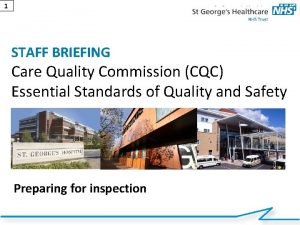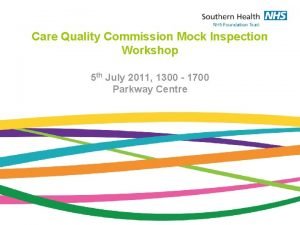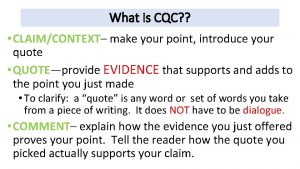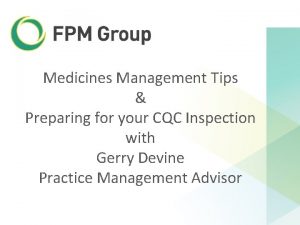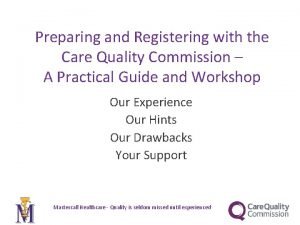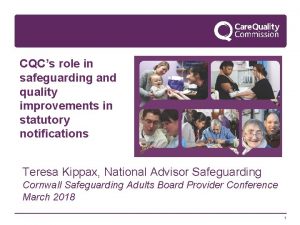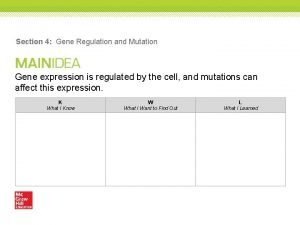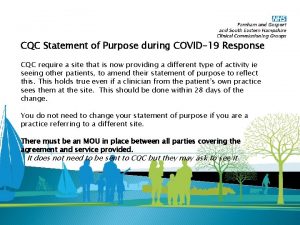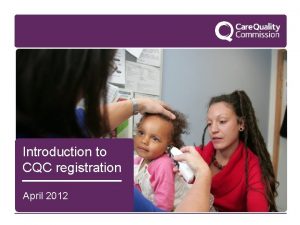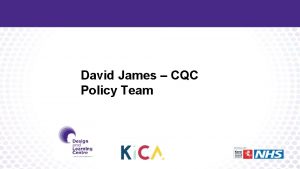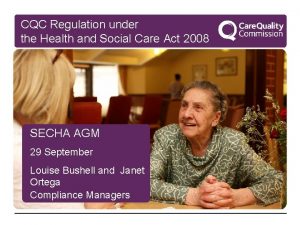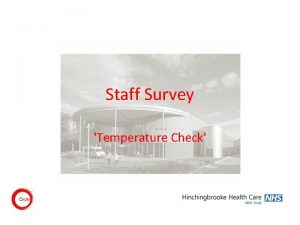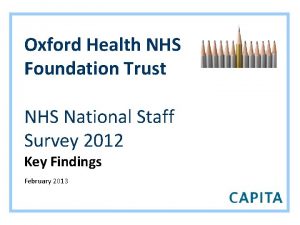NHS Staff Survey and CQC Regulation NHS Staff












- Slides: 12

NHS Staff Survey and CQC Regulation - NHS Staff Survey - Regulatory process and the Quality and Risk xx. Profiles (QRPs) x Elizabeth Spragg March 2011

The NHS staff survey • The NHS staff survey is an annual, national survey of NHS employees which began in 2003. • The Care Quality Commission has to date managed the Advice and Coordination Centre at Aston University which in turn coordinates the preparation and local administration of the survey by approved survey contractors. • Outputs • Summary feedback reports for all trusts in England: Data for 2010 (and 2009 if available) on 38 key scores, including rankings of their best and worst scores, benchmarked against other trusts) • Full feedback reports for all trusts in England: Data for 2010 (and 2009 if available) on 38 key scores, including rankings of their best and worst scores, benchmarked against other trusts, question by question reporting and breakdowns of the key scores by directorate, occupational groups and demography) • National briefing: Key findings and change, highlighting any sector specific differences, with comparison to 2009 2

Why does the NHS staff survey matter? • Staff views matter! Their attitudes to, and experience of, work: impact on their engagement and motivation dictate whether or not they offer additional discretionary effort help them decide whether to stay or leave • There are strong and proven links between people inputs and organisational outcomes: better patient safety outcomes: lower mortality rates, fewer medication errors, fewer patient falls, reduced clinical error rate greater patient satisfaction with care reduced staff absence levels lower workplace accidents lower employee turnover • There are therefore compelling arguments for gaining an in-depth understanding of staff views via the NHS staff survey 3

Who uses the survey data? • The results are primarily intended for use by NHS trusts to help them review and improve work experiences so that staff can provide better patient care. • The Care Quality Commission uses the results in a range of ways: including setting out national findings informing patients and the public of trusts’ results using the results to monitor ongoing compliance with essential standards of quality and safety: Quality and Risk Profiles • The Department of Health is working to ensure that accountability for improving staff experience and well-being is part of the new Health and Social Care system. The survey will also support accountability of the Secretary of State for Health to Parliament for delivery of the NHS Constitution. 4

CQC’s use of the staff survey – the registration process Application made Completing registration Application assessed Judgement made Judgement published Information capture Ongoing monitoring of compliance Information analysis Estimate of risk Regulatory response Regulatory judgement 5

CQC’s use of the staff survey – Quality and Risk Profiles • Bring together information about a care provider so as to estimate risk and prompt front line regulatory activity • Act as a guide and aid CQC’s inspectors • Not a judgement (or a rating, or a league table) in themselves • Build over time (and are never ‘perfect’) • Capable of using both numeric (quantitative) and textual (qualitative) data • Essential tool to support monitoring of compliance • Help inform subsequent judgements and add to the knowledge base about a care provider 6

Updating and sharing NHS QRPs • Updated regularly (schedule dependent upon type and source of data) • Currently shared with NHS providers in pdf format • To be shared via the web from summer 2011, as part of ‘QRP online’ project. • Aim is to make QRPs more accessible and interactive 7

Qualitative (textual) data items Quantitative (numeric) data items QRP risk estimates: key at data item level 8

Regulatory outcomes: 16 essential standards of quality and safety 9

QRP data item utility factors • Three factors can influence the weight individual data items hold within the QRP statistical model: • Relevance – how closely a data item relates to one of the essential standards • Data quality – how confident we are in the validity of the data item, including its age • User experience – how closely a data item reflects user experience • Every data item is given a score out of 3 (1 = low; 3 = high) for each of the utility factors, with the ability to ‘up-weight’ or ‘downweight’ over time 10

QRP risk estimates: key at outcome level • 10 possible dial positions 11

Questions?
